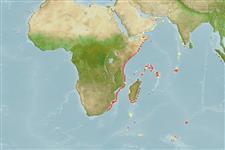>
Ophidiiformes (Cusk eels) >
Ophidiidae (Cusk-eels) > Neobythitinae
Etymology: Glyptophidium: Greek, glyptes = carver + Greek, ophis, ophidium, diminutive = serpent (Ref. 45335).
More on author: Norman.
Environment: milieu / climate zone / depth range / distribution range
Écologie
marin bathydémersal; profondeur 360 - 825 m (Ref. 34024). Deep-water
Western Indian Ocean: frequently encountered on the upper part of the continental slope off East Africa, reaches south to Bazaruto Island in Mozambique. Ranges extends to Durban, South Africa (Ref. 11228).
Taille / Poids / Âge
Maturity: Lm ? range ? - ? cm
Max length : 26.0 cm SL mâle / non sexé; (Ref. 11353)
Description synthétique
Morphologie | Morphométrie
Épines dorsales (Total): 0; Rayons mous dorsaux (Total): 121-145; Épines anales 0; Rayons mous anaux: 96 - 115. Prominent head and body with an attenuate caudal part; head bones with large, thin crests; eye equal to or greater than length of snout; opercular spine broad, flat and weak; basibranchial with 2 median and a pair of tooth patches; long gill rakers on anterior arch 21 to 41 (Ref. 34024). Caudal fin rays 7-8; stem of pseudobranchial filaments dark (Ref. 34024).
Common species (Ref. 34024). Oviparous, with oval pelagic eggs floating in a gelatinous mass (Ref. 205).
Life cycle and mating behavior
Maturité | Reproduction | Frai | Œufs | Fécondité | Larves
Nielsen, J.G., D.M. Cohen, D.F. Markle and C.R. Robins, 1999. Ophidiiform fishes of the world (Order Ophidiiformes). An annotated and illustrated catalogue of pearlfishes, cusk-eels, brotulas and other ophidiiform fishes known to date. FAO Fish. Synop. 125(18):178p. Rome: FAO. (Ref. 34024)
Statut dans la liste rouge de l'IUCN (Ref. 130435)
Menace pour l'homme
Harmless
Utilisations par l'homme
Plus d'informations
Noms communsSynonymesMétabolismePrédateursÉcotoxicologieReproductionMaturitéFraiRassemblement de ponteFéconditéŒufsDéveloppement de l'œuf
Taille/ÂgeCroissanceLongueur-poidsLongueur-longueurFréquences de longueursMorphométrieMorphologieLarvesDynamique des populations larvairesRecrutementAbondanceBRUVS
RéférencesAquacultureProfil d'aquacultureSouchesGénétiqueElectrophoresesHéritabilitéPathologiesTraitementNutrientsMass conversion
Outils
Articles particuliers
Télécharger en XML
Sources Internet
Estimates based on models
Preferred temperature (Ref.
123201): 2.1 - 11.8, mean 10.4 °C (based on 36 cells).
Phylogenetic diversity index (Ref.
82804): PD
50 = 0.5156 [Uniqueness, from 0.5 = low to 2.0 = high].
Bayesian length-weight: a=0.00380 (0.00165 - 0.00876), b=3.14 (2.93 - 3.35), in cm total length, based on LWR estimates for this (Sub)family-body shape (Ref.
93245).
Niveau trophique (Ref.
69278): 3.6 ±0.6 se; based on size and trophs of closest relatives
Résilience (Ref.
120179): Haut, temps minimum de doublement de population inférieur à 15 mois (Preliminary K or Fecundity.).
Fishing Vulnerability (Ref.
59153): Low vulnerability (22 of 100).
